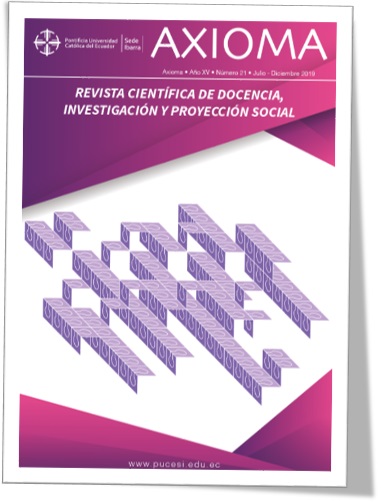Desarrollo y validación de un método en cromatografía líquida de alta eficiencia para la determinación depinocembrin en hojas de la especie piper ecuadorense sodiro
Main Article Content
Abstract
Pinocembrin is a flavanon e that shows pharmacological and biological activities such as antifungal, anticancer, antimicrobial, anti-inflammatory, and antioxidants. This secondary metabolite has been identified in several plants belonging to the Piperaceae family. Piper ecuadorense is a native shrub used in traditional medicine by healers from the Saraguro indigenous community of Ecuador. Therefore, due his important activity, it is necessary develop and validate a method by using HPLC-DAD in order to determinate the pinocembrin in Piper ecuadorense leaf extracts. The method utilized a BDS Hipersil C-18 column (5 μm, 4.6x250 mm i.d.) with the mixture of ammonium acetate (0.01 M) and methanol (35:65 %, v/v) as the mobile phase at a flow-rate of 1 mL/min, and detection was by UV at 290 nm. The parameters of linearity, accuracy, precision, recovery, detection limit, and quantitation limit of the HPLC method were achieved. The method showed excellent linearity (r2 = 0.9998), and the recovery was 100.70-101.33%. A high degree of accuracy and precision (RSD less than 3% for intraday and interday) were likewise reached. In this way, a simple, precise, accurate and reproducible HPLC method was successfully developed and validated to analyze pinocembrin in Piper ecuadorense leaf extracts.
Downloads
Article Details
Con la finalidad de contar con un tipo de licencia más abierta en el espectro que ofrece Creative Commons, a partir de diciembre de 2022 desde el número 27, AXIOMA asume la Licencia Creative Commons 4.0 de Reconocimiento-NoComercial-CompartirIgual 4.0(CC BY-NC-SA 4.0). Tanto el sitio web como los artículos en sus diferentes formatos, reflejan esta información.
![]()
Hasta el mes de noviembre de 2022 con el número 26, la revista AXIOMA asumió una Licencia Creative Commons Atribución-NoComercial-SinDerivadas 4.0 Internacional (CC BY-NC-ND 4.0). Los artículos contenidos en cada número hasta el 26, cuentan con esta licencia y su descripción se conserva en el portal de nuestra revista.
Atribución-NoComercial-SinDerivadas
CC BY-NC-ND
AXIOMA- Revista Científica de Investigación, Docencia y Proyección Social
References
Guo, W., Jiang, Y., Chen, X., Yu, P., Wang, M., Wu, X., Zhang, D., 2015. Identification and quantitation of major phenolic compounds from penthorum chinense pursh. by HPLC with tandem mass spectrometry and HPLC with diode array detection. J. Sep. Sci. 38, 2789–2796. https://doi.org/10.1002/jssc.201500303
Merken, H.M., Beecher, G.R., 2000. Measurement of food flavonoids by high-performance liquid chromatography: A review. J. Agric. Food Chem. 48, 577–599.
Ramírez, J., Cartuche, L., Morocho, V., Aguilar, S., Malagon, O., 2013. Antifungal activity of raw extract and flavanons isolated from Piper ecuadorense from Ecuador. Brazilian J. Pharmacogn. 23, 370–373. https://doi.org/10.1590/S0102-695X2013005000012
Rasul, A., Millimouno, F.M., Ali Eltayb, W., Ali, M., Li, J., Li, X., 2013. Pinocembrin: A Novel Natural Compound with Versatile Pharmacological and Biological Activities. Biomed Res. Int. 2013, 9. https://doi.org/10.1155/2013/379850
Sala, A., Recio, M.C., Schinella, G., Máñez, S., Giner, R., Cerdá-Nicolás, M., RıÌos, J.-L., 2003. Assessment of the anti-inflammatory activity and free radical scavenger activity of tiliroside. Eur. J. Pharmacol. 461, 53–61. https://doi.org/http://dx.doi.org/10.1016/S0014-2999(02)02953-9
Shah, V., Midha, K., Findlay, J., Hill, H., Hulse, J., McGilveray, I., McKay, G., Miller, K., Patnaik, R., Powell, M., Tonelli, A., Viswanathan, C., Yacobi, A., 2000. Bioanalytical Method Validation—A Revisit with a Decade of Progress. Pharm. Res. 17, 1551–1557. https://doi.org/10.1023/a:1007669411738
Tene, V., Malagón, O., Finzi, P.V., Vidari, G., Armijos, C., Zaragoza, T., 2007. An ethnobotanical survey of medicinal plants used in Loja and Zamora-Chinchipe, Ecuador. J. Ethnopharmacol. 111, 63–81. https://doi.org/http://dx.doi.org/10.1016/j.jep.2006.10.032
U.S. Department of Health and Human Services Food and Drug Administration, Center for Drug Evaluation and Research (CDER), Center for Veterinary Medicine (CVM), 2018. Bioanalytical Method Validation Guidance for Industry.
Wangkangwan, W., Boonkerd, S., Chavasiri, W., Sukapirom, K., Pattanapanyasat, K., Kongkathip, N., Miyakawa, T., Yompakdee, C., 2009. Pinostrobin from Boesenbergia pandurata Is an Inhibitor of Ca 2+ -Signal-Mediated Cell-Cycle Regulation in the Yeast Saccharomyces cerevisiae. Biosci. Biotechnol. Biochem. 73, 1679–1682. https://doi.org/10.1271/bbb.90114
Yang, Z., Liu, R., Li, X., Tian, S., Liu, Q., Du, G., 2009. Development and validation of a high-performance liquid chromatographic method for determination of pinocembrin in rat plasma: Application to pharmacokinetic study. J. Pharm. Biomed. Anal. 49, 1277–1281. https://doi.org/http://dx.doi.org/10.1016/j.jpba.2009.02.030

